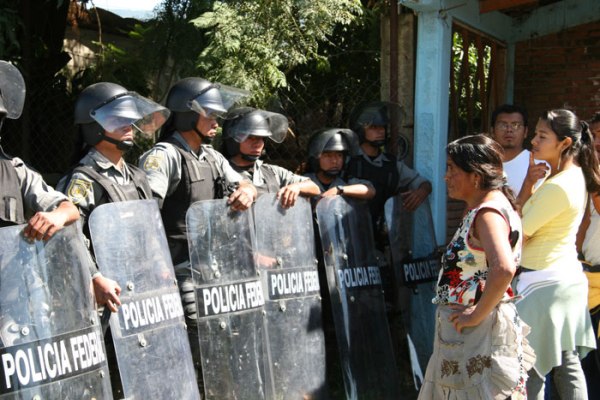The taking of Channel 9
Women in Oaxaca Make a Stand for Local Teachers
The image of women on Mexican television is usually one of glamour: Swooning soap opera beauties of the telenovelas, or voluptuous game show hostesses in tight shiny dresses.
But in the summer of 2006, the citizens of the southern state of Oaxaca turned on their TVs and saw a very different view: Everyday women, in everyday clothes, wielding spoons and pots and pans. They had a message, and in order to get it told, they had taken over the local television station.
In the beginning, the civil disobedience was not organized primarily by women. Oaxaca teachers decided to strike to demand higher federal and state education budgets. They set up a protest camp in Oaxaca City, a tent city that filled the touristy town square and stretched out for blocks, housing tens of thousands of teachers from across the state.
Oaxaca Governor Ulises Ruiz Oritz refused to meet with the teachers' union or answer their demands. Instead, he sent state riot police using tear gas and helicopters to dismantle the striking teachers' camp, leaving scores of men, women, and children injured.
The city exploded. Thousands took to the streets to help the teachers, tend the injured, and offer food and water. But to everyone's surprise, these citizens went one step further--they counterattacked, retook the town square, and drove the police out of town.
This spontaneous rejection of police violence, along with the outpouring of support for the teachers, ignited a five-month civil disobedience uprising. It would put a half million people on the streets in marches and tens of thousands in protest camps across Oaxaca City, paralyze the state government, and send the governor into hiding.
Indigenous organizations, human rights groups and local unions joined the teachers in calling for the Governor's resignation for ordering the police raid. Initially, protest leaders were was almost entirely male, with women relegated to lesser roles. Undaunted, women formed neighborhood groups in order to participate and joined marathon discussions that guided the protesters' actions. In the summer of 2006, they cooked up the idea of a women-only march.
The march drew some 5,000 women, all banging on pots and pans with meat tenderizers, ladles, and soup spoons. The raucous cacophony had the women so jazzed that when they reached their destination (the protester-occupied town square), they decided to keep going, to the state-owned television station, Channel 9. The only statewide local station, Channel 9 failed to report on the police violence and later presented the protesters as vandals and hooligans. At first the women demanded only an hour on television to tell their version of the events and why they wanted Ruiz out of office. But the station director refused. The women asked for less time, then even less, but were repeatedly rebuffed. Finally, they walked past the director, with pots and pans in hand, and took over the station.
Employees had taken the station off the air as the women stormed the office. Now the women scrambled to get the station back on the air, trying to figure out the cameras and sound system, before the police came to retake the station.
But the police did not come. Instead, thousands of residents from the surrounding neighborhood flooded the streets to guard the station, taking over city buses and parking them across the street to block all approaching traffic.
Within three hours, for the first time in Mexican history, a protest movement occupied a state television station and broadcast live. Viewers saw a tight group of women without makeup or designer dresses, pots and pans still in hand, all facing the camera. Their message: if the media insist on airbrushing state violence from the news and distorting social protest into an "urban guerrilla" movement, then the people will take the media in order to tell their own story of suffering, police repression, and organizing social protests.
Excerpted from "In Oaxaca, Women Rise" by John Gibler, originally published in Is The U.S. Ready for Human Rights?, the Spring 2007 YES! Magazine.


